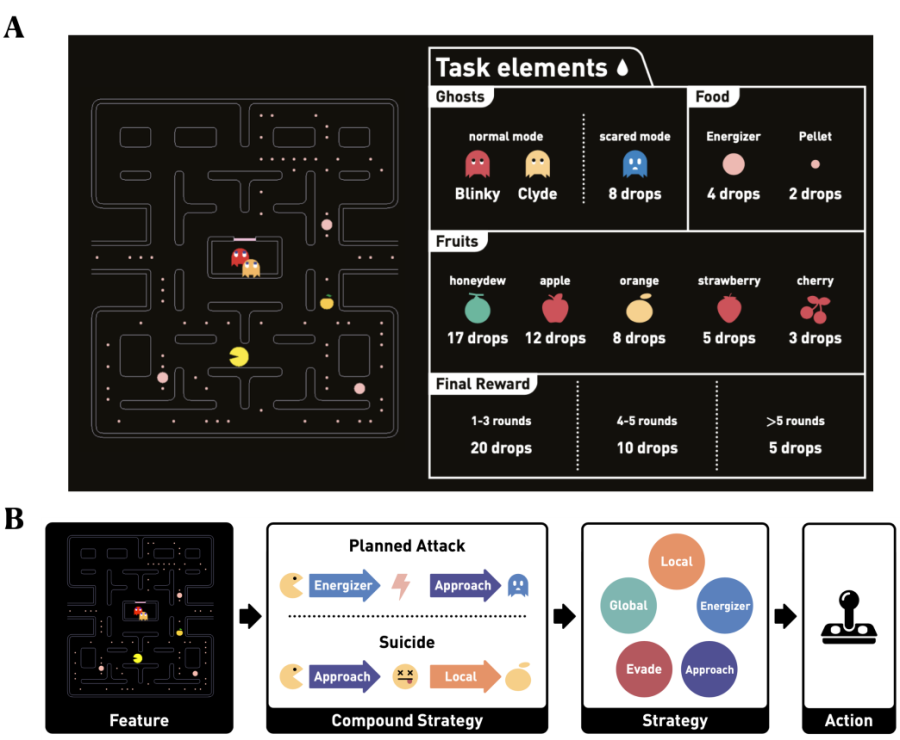Time:2022-04-03
A recent study published in eLife demonstrated that non-human primates (rhesus monkeys) can play the video game Pac-Man with complex heuristic behavioral strategies. This work was performed by researchers in Dr. YANG Tianming’s Lab at the Institute of Neuroscience, Center for Excellence in Brain Science and Intelligence Technology of the Chinese Academy of Sciences, Key Laboratory of Primate Neurobiology. The authors trained two macaque monkeys to use a joystick to play a semi-controlled version of the video game Pac-Man. The novel experimental paradigm allowed the authors to analyze and model the kinds of heuristic behavioral strategies monkeys use to solve complex problems. The results provide insights into higher cognition functions in non-human primates.
Our lives are full of ambitious goals to achieve. Often, the goals we set out to accomplish are beyond the reach of any straightforward decision-making tactics. They, however, may be approached with a specific and elaborate set of basis strategies. With each strategy, individuals may prioritize their gains and risks according to the current situation and solve the decision-making within a smaller scope. As we live in a dynamic world that presents us with unexpected disturbances, it is also crucial to have the flexibility to alter our course of strategies accordingly. Additionally, the basis strategies can be pieced together and combined into compound strategies to reach grander goals. Despite the continuing effort in studying complex behavior in animals and the underlying neural mechanisms, the level of complexity of the existing animal behavioral paradigms is insufficient for studying how animals manage strategies to simplify a sophisticated task.
In order to address these questions, the researchers adapted the popular arcade game Pac-Man (Fig. A). The game was tweaked slightly for the macaque monkeys. Just as in the original game, the monkeys learned to use a joystick to control the movement of Pac-Man to collect all the pellets inside an enclosed maze while avoiding ghosts. The monkeys received fruit juice as a reward instead of earning points. The animals were able to learn how each element of the game led to different reward outcomes and made continuous decisions accordingly. While the game is highly dynamic and complex, it is essentially a foraging task, which may be the key to the successful training.
The game has a clear objective, but an optimal solution is computationally difficult. However, a set of intuitive strategies would allow players to achieve reasonable performance. To find out whether the monkeys’ behavior can be decomposed into a set of strategies, we fit their gameplay with a dynamic compositional strategy model, which is inspired by recent advances in the artificial intelligence field in developing AI algorithms that solve the game with a multiagent approach. The model consists of a set of simple strategies, each considering a specific aspect of the game to form decisions on how to move Pac-Man. By fitting the model to the behavior of the animals, we were able to deduce the strategy weights. The model was able to achieve over 90% accuracy in explaining the decision-making of the monkeys. More importantly, the strategy weights revealed that the monkeys adopted a take-the-best (TTB) heuristic by using a dominant strategy and only focusing on a subset of game aspects at a time. In addition, the monkeys were able to use the strategies as building blocks to form compound strategies to handle particular game situations. Our results demonstrated that animals are capable of managing a set of compositional strategies and employing hierarchical decision-making to solve a complex task (Fig. B).
The study presents findings of broad interest to behavioral, systems, and cognitive neuroscientists. The combination of a complex behavioral paradigm and sophisticated modeling provides significant insight and a novel approach to studying higher cognition in primates.
This work entitled “Monkey plays Pac-Man with compositional strategies and hierarchical decision-making” was published online in eLife, on March 14, 2022. Qianli Yang is the first author. Zhongqiao Lin, Wenyi Zhang, Jianshu Li, Xiyuan Chen, and Jiaqi Zhang are contributing authors. This work was supported by the National Science and Technology Innovation 2030 Major Program, the CAS, the Shanghai Municipal Science and Technology Major Project, and the NSFC.

Figure legend: (A) Behavioral paradigm. (B) Monkeys’ decision-making in different hierarchies. At the lowest level, decisions are made for the joystick movements: up, down, left, or right. At the middle level, choices are made between the basis strategies. At a higher level, simple strategies may be pieced together for more sophisticated compound strategies. Monkeys may adopt one of the compound strategies or just a basis strategy depending on the game situation.
https://elifesciences.org/articles/74500
Keywords: cognition, decision making, behavior modeling, strategy
AUTHOR CONTACT:
Yang Tianming
Center for Excellence in Brain Science and Intelligence Technology, Chinese Academy of Sciences, Shanghai, China.
E-mail: tyang@ion.ac.cn
 附件下载:
附件下载: